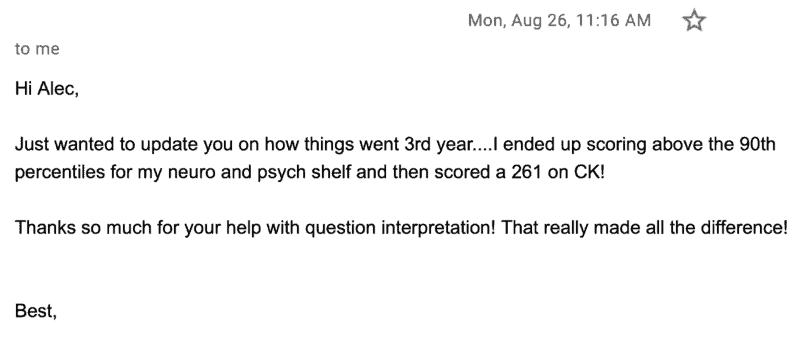

Ever wondered what the difference is between someone who scored 240-250+ on the USMLE vs. an average score? If you’re like most people, you probably assume that it has everything to do with knowledge.
What if I told you that knowledge was only part of the equation? (And that for Step 2 CK especially, it’s a tiny part of the equation). Instead, what leads to high USMLE scores has much more to do with approach.
In this article, you will learn:
- The mentality that will help you improve your score without having to learn more,
- Why many people recommend reading the last sentence first (and why they’re wrong),
- How you should study so that you improve the likelihood of getting ANY question right on your exam,
- And much more!
Table of Contents
Why Do You Study the Way You Study?
Med students obsess about the USMLEs. There are good reasons for this:
- Scores are often used for cut-offs for interviews in competitive fields or hospitals
- Low scores can make attaining a particular residency much harder
- High scores can make up for “gaps” in our residency applications
As such, our approach to the USMLEs often comes in up conversations. At the least, you’ve asked someone what they did to study.
While conversations usually focus on WHAT someone did, they rarely focus on WHY. That’s a problem in and of itself. Med students aren’t particularly self-reflective people. If you were to ask someone why they did something, the rationale is usually:
- It’s what other people are doing, or
- There are some questions I (or others) have gotten right by doing this
Let’s talk about each.
It’s What Other People Are Doing
There is comfort in doing things that others are doing. It is reassuring. If we see a bunch of people buying a particular brand of clothes, it feels better to buy that brand. The same is true of studying.
I get it. But what if others haven’t realized they are wrong (yet)? Specifically, what if most people are busy memorizing UWorld/First Aid? They will recognize it EVENTUALLY, but for most of them, it will be too late.
Another way to think about this is that following the average will lead to average results. Following what the average student is doing is a quick way to achieve what the average student does.
My advice? Think for yourself. Look at USMLE-style questions to see what is necessary to answer them. It’s rarely the straight facts most people cram using things like Zanki. (For the sake of your sanity/score, please don’t use Zanki). Even better, look at the NBME’s own words on how they write questions. They write questions to weed out memorizers.
I’ve Gotten Some Questions Right By Doing X, So it Must Be Right
If I do something, and at least some of the time it is successful, I expect if I do it more, it will lead to more success. That is a natural conclusion, and there is a degree of truth to it.
However, this is the WRONG question to be asking. If I told you that I got a USMLE question right by reading a math textbook, should you scrutinize the math textbook? No, of course not. However, why do you use a particular resource just because you “might” get some questions right on an exam?
Don’t ask whether a resource might help you get SOME questions right. Instead, ask yourself this:
What approach will allow me to get the MOST questions right
It’s like in basketball. I could shoot the basketball from half-court. Heck, I could take a lot of shots from the opposite side of the court. A certain percentage of shots would go in. But just because I can make SOME shots, doesn’t mean it’s a good strategy.
NBA analytics gives us the following approximate shot values:
- 2-point shot within 3 feet of the basket: 1.3 points/shot
- 2-point shot much farther from the basket: 0.8 points/shot
Nominally, each shot is with the same amount. However, shots from farther out are worth less, because the chances of making them are lower.
How People Justify Reading the Last Sentence First (and Why They’re Wrong)
Let’s look at an example of the “X works sometimes, so it must be right” fallacy. It’s advice you see everyone on the internet: read the last sentence first.
The justification usually boils down to two points:
- Knowing the question in advance helps focus my attention
- Sometimes you can answer the question from knowing the last sentence
We’ve discussed by knowing the question in advance rarely helps with question interpretation. So here, we’ll discuss the second justification.
Don’t Ask: “Can I Get the Question Right by Reading the Last Sentence?” Do Ask: “What is the Net Time Spent/Saved by Reading the Last Sentence?”
If you’ve done NBME questions, you’ve seen that you don’t have to read every sentence for every item. In fact, sometimes, you only have to read the last sentence.
This is a fact. However, what that does NOT justify reading the last sentence first every time. Why? Because the time spent reading the final sentence doesn’t justify the time required.
Let’s look at an example. Let’s say that:
- Every question’s time allotment is 90 seconds
- Every block is 40 questions
- Reading/processing the last sentence takes 5 seconds
- Reading the answer choices takes 10 seconds
Reading the last sentence 40 times takes an extra 200 seconds (at least). At most, on a question where the last sentence tells you everything, you may save 75 seconds.
Would you spend 200 seconds (more than 2 questions’ allotment) to save 75 seconds? Only if there were at least 3 questions per block where knowing the last sentence was enough.
Don’t Take My Word: Test for Yourself
Now we have the outlines of a rational approach to test-taking. The break-even point is about 3 questions. Meaning if there are 3 questions that I can “skip” by reading the last sentence first, the strategy is a time-saver. If not, then you’re wasting time and likely decreasing your score.
There are free samples of USMLE questions online you can use to test this. You can also make a 40-question block in a QBank. Or look at an NBME practice exam. I’ll wait.
What did you find? I’d be shocked if your test had even one question/block on average that could be answered by the last sentence. It may be one question every other block. It’s not very common.
That Basketball Analogy Again
The analogy with basketball here is clear. Just because I CAN make a particular shot doesn’t mean it is a GOOD shot. As we saw above, a long 2-pointer is worth about 0.8 points/shot. An attempt within 3 feet of the basket is worth about 1.3 points/shot. Both are nominally worth the same amount. However, the shots are not equal.
In USMLE terms, just because I can get a question right from reading the last sentence, doesn’t mean I should do it.
Here’s another example of why it’s not enough for a strategy to work only sometimes. You can indeed get an item right by reading the last sentence. But it’s also occasionally true you could get the critical information from the fourth sentence.
So, you should you read the fourth sentence of every question! Why not? Sometimes you’ll get the problem right! My friend told me it worked on some of his Step 1 questions.
Obviously, it’s absurd to read the fourth sentence first. But not much more ridiculous than reading the last one.
Every Time You Understand More About the Vignette, You Take a Step Closer to the Rim
We’ve just discussed some ways that likely won’t improve your accuracy. However, what can we do for every question to enhance the likelihood of getting that question?
In my experience, to get a 220-230, you need proper knowledge. However, to score 240-250+, you need to reduce your unforced errors. In basketball terms, adequate knowledge is likely improving your overall shooting. With sufficient knowledge, every shot I take, regardless of the distance to the basket, has a higher chance of going in. But there are limits to how much knowledge can help. To increase your score further, you have to move closer to the basket.
In other words, you need to make every long 2-pointer into a layup. The more you can do this, the better your score will be.
Many best practices can improve your accuracy. Each thing may not seem to make a tremendous difference. It’s like taking one step closer to the rim when you’re shooting. Each step may not seem like much. However, when added up, your accuracy can go up dramatically. Averaged over an entire exam, this improved accuracy can have a dramatic effect on your score.
Have lots of USMLE knowledge is like being a great shooter like Steph Curry. Any shot he takes has a higher likelihood of going in. However, even Steph Curry has improved accuracy the closer he is to the basket. In other words, even the best shooter in the world misses more shots he takes farther from the basket.
Question interpretation is what allows you to go from a long 2 into a layup.

Work on understanding what every sentence in every vignette means. You’ll turn more low-probability shots into layups.
How Question Interpretation Turns Long 2’s into Layups
Question interpretation is how you know the meaning behind everything in the vignette. If the patient has uncontrolled diabetes, you know why the author made that decision. When the patient feels lightheaded on standing, you see the significance.
Let’s use an abbreviated example you could see on your exam:
A 39-year-old man comes in with six months of worsening fatigue and weakness. He has decreased appetite, interest, energy, libido, erectile dysfunction, and cold intolerance. He also reports a worsening, dull constant headache over the past several months. His vitals are T 37 C, HR 55/min, BP 99/70, RR 15/min. His skin is dry and pale. Labs are significant for sodium of 131 mEq/L and glucose 56 mg/dL. CBC demonstrates:
WBC 6,000
Neutrophils 45%
Lymphocytes 40%
Eosinophils 10%
Hgb 12 g/dL
Platelets 150,000
What would the patient’s serum cortisol, ACTH, and aldosterone be?
How did you do? This is precisely the kind of question you could see on your exam. Everything listed has a purpose, even if you don’t know it. Did you catch that the eosinophil count was high? Or that the lymphocytes were higher than expected? Did you know why that was?
In all likelihood, you had no idea what 50% of the sentences meant. You may have thought “hypothyroidism,” but you also likely thought a host of other things. How do you know which of those thoughts is right or wrong? You may not have.
But what if I told you you should have known the diagnosis by the third sentence? Would you believe me? Let me show you how.
A High-Percentage Approach to Answering Questions
The high-percentage approach to questions is to know what every sentence means. Here is what every sentence means:
“A 39-year-old man comes in with six months of worsening fatigue and weakness.”
Fatigue and weakness are pretty non-specific. A lot of different organ systems could give you these symptoms, so best to move on.
“He has decreased appetite, interest, energy, libido, erectile dysfunction, and cold intolerance.”
There is a mix of more specific and less specific symptoms here. Decreased appetite is non-specific – anorexia has a large number of possible causes. Ditto for low interest/energy. Loss of libido/erectile dysfunction suggests possible sex hormone decrease. And cold intolerance is suggestive of hypothyroidism.
“He also reports a worsening, dull constant headache over the past several months.”
This is the sentence by which you should have known the diagnosis, or at least had a good idea. By itself, a worsening dull headache might not mean anything. But with signs of low/abnormal hormones, you’d be concerned for a pituitary tumor. Why? Because a pituitary tumor (like a prolactinoma) could grow large enough to give you both:
- A headache (mass effect), and
- Compress the anterior pituitary → ACTH, TSH, FSH/LH ↓
If You Don’t Know the Diagnosis by the Third Sentence, the Rest of the Vignette Won’t Help
The rest of the question hinges on you making this insight from the first 3 sentences. If you thought “pituitary adenoma” by the third sentence, you’ve got yourself a layup. If you thought, “I don’t have enough information, let me read more”? You’re looking at a very low-probability shot. Not impossible to make, but with a much lower likelihood of success.
Don’t believe me? Read the rest of the vignette:
His vitals are T 37 C, HR 55/min, BP 99/70, RR 15/min. His skin is dry and pale. Labs are significant for sodium of 131 mEq/L and glucose 56 mg/dL. CBC demonstrates:
WBC 6,000
Neutrophils 45%
Lymphocytes 40%
Eosinophils 10%
Hgb 12 g/dL
Platelets 150,000
What would the patient’s serum cortisol, ACTH, and aldosterone be?
Few people would be able to tell the diagnosis from the last half of the vignette. Why? Because none of these findings are specific. Lots of things can give you hyponatremia, hypoglycemia. The differential for things giving you “eosinophilia” would be vast.
Knowing the Diagnosis by the Third Sentence Improves Accuracy and Timing
However, now think, “panhypopituitarism” and read the rest of the vignette:
His vitals are T 37 C, HR 55/min, BP 99/70, RR 15/min. His skin is dry and pale. Labs are significant for sodium of 131 mEq/L and glucose 56 mg/dL. CBC demonstrates:
WBC 6,000
Neutrophils 45%
Lymphocytes 40%
Eosinophils 10%
Hgb 12 g/dL
Platelets 150,000
What would the patient’s serum cortisol, ACTH, and aldosterone be?
What did you notice? Did framing the question help you interpret the rest of the vignette? Amazing, no?
What Your Interpretations Should Look Like by the Time You Get to Your USMLE
Here is the interpretation of the vignette:
His vitals are T 37 C, HR 55/min, BP 99/70, RR 15/min. (Adrenal insufficiency → low blood pressure)
His skin is dry and pale. (Hypothyroidism)
Labs are significant for sodium of 131 mEq/L and glucose 56 mg/dL. (Hypothyroidism and adrenal insufficiency)
CBC demonstrates:
WBC 6,000
Neutrophils 45%
Lymphocytes 40% (low cortisol → lymphocyte survival ↑; recall cortisol causes lymphocyte apoptosis)
Eosinophils 10% (low cortisol → eosinophil survival ↑; recall cortisol causes eosinophil apoptosis)
Hgb 12 g/dL
Platelets 150,000
What would the patient’s serum cortisol, ACTH, and aldosterone be? (This question is asking:
“What would the serum cortisol, ACTH, and aldosterone be in secondary adrenal insufficiency?”
Every Time You Know What a Sentence Means, You Take a Step Closer to the Basket
Notice how:
- Making the correct judgment from the first 3 sentences makes the rest of the vignette make sense
- Knowing what every sentence means makes it much easier to get the question right
- Reading the last sentence would have been a waste of time
My argument to you is simple. The more you understand about the vignette, the higher your chances of getting it right. So simple! It’s like every sentence you interpret correctly brings you closer to the basket. It doesn’t guarantee you’ll make the shot. However, throughout your test/game, the odds favor you immensely.
Having said this, you likely have two different objections. Let me address them here.
Objection #1: “But, I Can Get Questions Right Without Knowing What Every Sentence Means!”
“But I’ve gotten questions right even though I don’t know what everything means!” Yes, that is true. But just like I can make a certain number of shots by closing my eyes doesn’t mean I should do it. Only skimming for buzzwords may give you some answers, but it’s not a good long-term strategy.
Objection #2: “I Don’t Have Time to Do This On My Test”
You’re probably wondering, too, how you could do this in 90 seconds? The truth is, if you expect lightning to strike on the day of your exam, you’ll be disappointed. Instead, how you prepare is everything.
In other words, like anything, learning question interpretation is a skill. You need to start early – and practice often – to be able to do this in 90 seconds. But with the right preparation, you can do this. In fact, people who’ve mastered question interpretation often answer questions FASTER than before. Why? Because when you spend more than 90 seconds on an item, it’s not because you’re a slow reader. It’s because you’ve had to re-read the vignette multiple times.
By interpreting a question well, you only have to read each vignette once. And by only having to read each item one time, you can finish in less time.

Problems with timing on your exam have to do with improper preparations beforehand. (It’s NOT because you’re a slow reader). Instead, make pathophysiologic chronologies to improve your accuracy and speed.
How You Can Improve Your Question Interpretation Now
Have I convinced you to stop buzzword-scanning? If so, then you’re probably wondering how you can learn to interpret questions. Knowing the importance of understanding each vignette doesn’t explain how to do it!
The strategy we teach people in the Yousmle Online Course is this:
If you don’t know what each element means, make a pathophysiologic chronology.
What is the Pathophysiologic Chronology?
A pathophysiologic chronology explains in chronologic order what happened to the patient. It is the “story behind the story.” For the above example, the pathophysiologic chronology would be:
Lactotroph neoplasia → anterior pituitary mass → compression of other anterior pituitary cells / worsening headache → ACTH / TSH / FSH/LH ↓
ACTH ↓ → cortisol ↓ → gluconeogenesis/insulin resistance ↓ (hypoglycemia) + apoptosis of eosinophils/lymphocytes ↓ (eosinophilia)
LH/FSH ↓ → testosterone ↓ → libido ↓ / erectile dysfunction
TSH ↓ → thyroid hormone ↓ → cold intolerance, fatigue
Forcing yourself to make sense of every sentence improves your understanding. And better understanding leads to a better interpretation of this and other vignettes.
If you haven’t made sense of something before your test, you aren’t likely to do so on your exam. Spend the time before your test to create useful pathophysiologic chronologies for vignettes.
Concluding Thoughts
I love getting emails from students after they take their test. My favorites are from students who had previously had a disappointing USMLE experience. Like the many students I’ve had who had frustrating Step 1 scores but changed their approach.
Here’s an email I had from just such a student:

This student used question interpretation to rock their Shelf exams and score 261 on Step 2 CK
This was a student who wanted desperately to match into a ROAD specialty in New York. She had a disappointing Step 1 score. She worked hard on question interpretation, and her scores improved. Dramatically.
The Most Common Mistake Students Make in Their Approach
The biggest mistake I see students make is they ask themselves:
“What strategy will help me answer some questions?”
Instead of asking,
“What strategy will maximize my score?”
Notice the difference. There are lots of things that CAN lead to getting questions right some of the time. Few strategies will lead you to improve your odds on every item.
I can make a shot doing just about anything in basketball. I could:
- Shoot underhand
- Kick it into the hoop
- Shoot with my eyes closed
Sometimes, I’ll even make it!
But making a shot some of the time doesn’t make it a good strategy. Instead, I need to find the best technique and shot-selection to maximize my score. That’s what NBA teams are increasingly focused on. And that’s what you need if you want to score 240-250+ on Step 1 or Step 2 CK.
If you want to learn how to make long 2’s into layups, sign up for the Online Course. Here, we teach you not only how to improve your chances of getting every USMLE question right. You’ll also receive:
- Pathophysiologic chronology Anki cards,
- Content modules on the most poorly understood topics, and
- Step-by-step instructions on how to approach any question,
All so you spend more time mastering information for a higher score, faster.
To sign up for the Online Course, click here.
Photos by Alec baker, Veri Ivanova








Alec, this was such an amazing post. I find your work extremely valuable and insightful. Sharing with my fellow classmates. Thanks again. Be safe.
Thanks so much for your kind words and for spreading the word!
Why does the patient have hyponatremia? Aldosterone is not under the effect of pituitary hormones, its regulated by ATII and potassium levels.